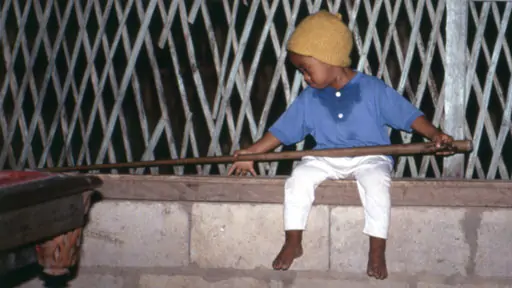Indigenous Calendar August, 2011: Changes and Adaptation in an Aeta Village

If I had to choose a personal, favorite image from our documentary, Peoples of the World: Southeast Asia, this would be it.
I'd been invited to stay in an Aeta village in the Philippines. My four-day visit was filled with enough experiences to write a thousand stories. Of those stories, one that made a deep impression was the story of change. The Aeta were possibly the first people to inhabit the Philippines. Among indigenous peoples today they must be among the few whose collective experience ranges from close to their original situation to being on the cusp of the Twenty-first Century. On my first afternoon in the village I was given a demonstration of making fire from bamboo and grass; yet a few hours later, as it started to get dark, villagers gathered at my host's house to sing karaoke!
It was then that I knew that one of the themes of the documentary would be "changes." Later I observed so many examples of changes in this and other indigenous villages that I soon realized that "changes" would be a chapter by itself (in the end it was titled Changes and Adaptation).
Each time I wandered around the village I made new discoveries about both traditional and modern Aeta life. Older people tended to go to sleep quite early, but by mid-evening the village was full of younger people engaged in all kinds of pastimes from playing basketball in the dark to singing traditional Aeta songs.
I think it was on my last night in the village that the "village hall" had been set up with the karaoke machine to become a kind of '70's-style discotheque. In the mood for neither singing nor dancing I retired to the back of the hall to observe the event and to look for photo-taking opportunities. To my surprise the back of the hall was a "pool hall." Although the tables weren't in great condition they were reasonable and I was invited to play and I accepted the invitation.
I soon noticed this young boy, who I assumed was the son of one of the players, looking half-asleep in a chair (it was way past a healthy bedtime for such a young boy). Eventually one of the adults noticed him also and set him up with a pool cue (presumably just to try to keep him awake so that he — the adult — could continue playing). Drowsy from both the hour and the heat he couldn't have posed for a better portrait to represent change if I'd tried to pose him myself.
The Aeta are featured in our documentary, Indigenous Peoples of Southeast Asia.
If you enjoyed reading this article, please consider supporting independent, advertising-free journalism by buying us a coffee to help us cover the cost of hosting our web site. Please click on the link or scan the QR code. Thanks!


